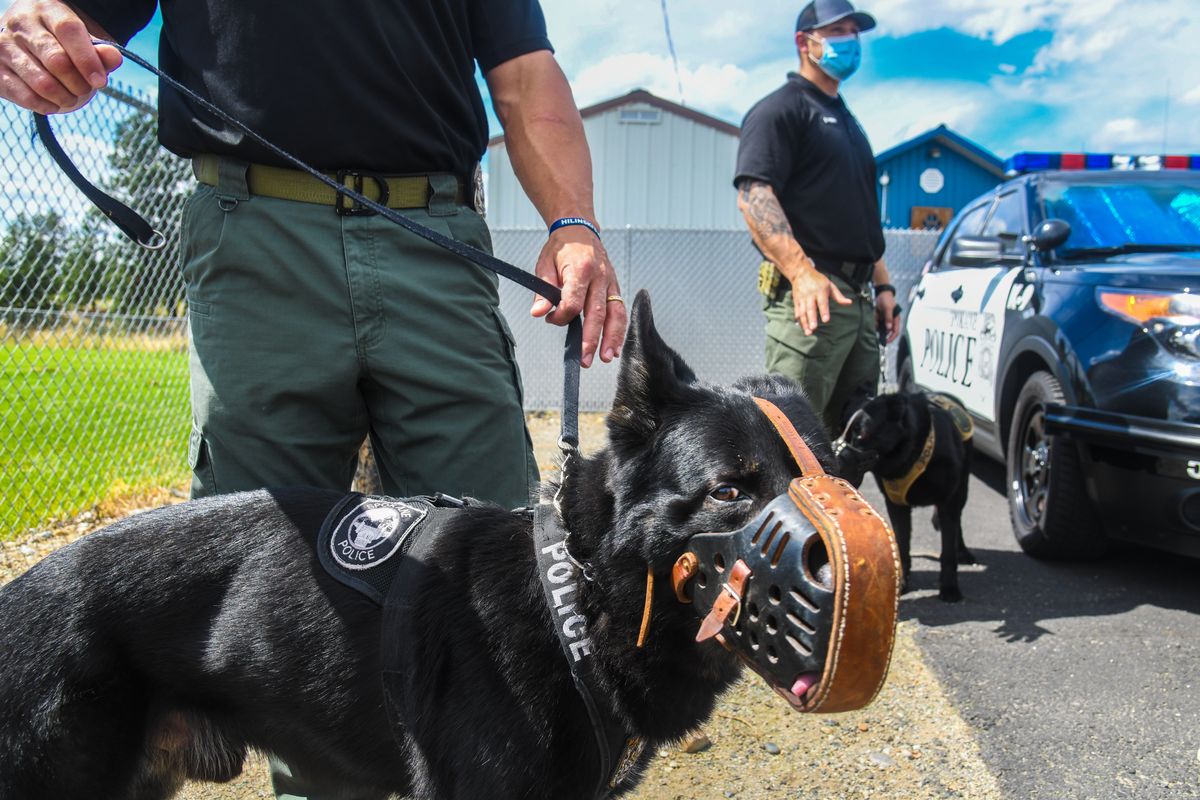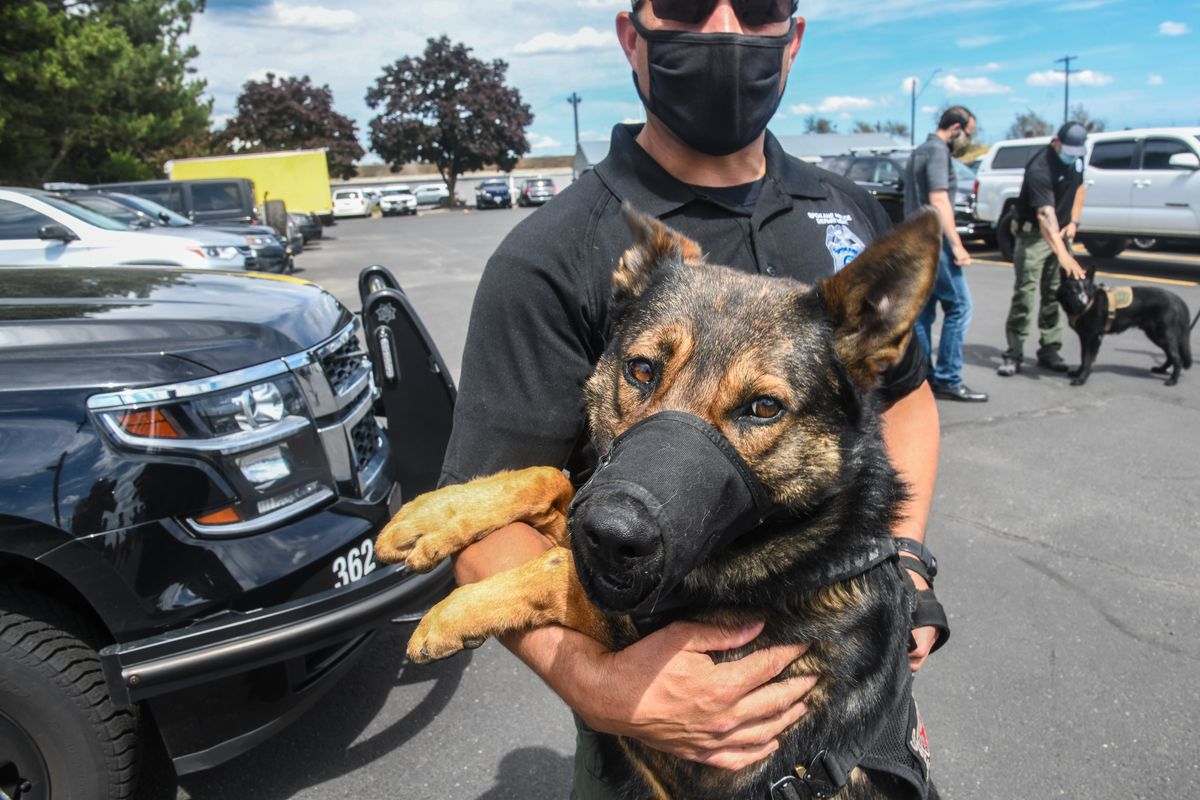Are dog bites deescalation? Spokane police say yes as council considers limits on K9 use

As the use of force by Spokane police officers has come under scrutiny, so too has that of their canine colleagues.
Last month, Spokane City Council President Breean Beggs proposed a broad set of police reforms, including new limits on the Spokane Police Department’s use of a police dog to apprehend a suspect.
Under Beggs’ proposal, a dog bite would be categorized as deadly force and require greater justification by the officer who handles the canine.
The department is pushing back, with K-9 unit leaders and officers arguing Beggs’ proposal lacks nuance, misunderstands deadly force and would essentially render police dogs obsolete.
The Spokane Police Department called on its K-9 unit – which consists of six dogs, all trained to “search and apprehend” – more than 1,000 times last year, resulting in 25 bites. That accounted for about one-fifth of the department’s reported uses of force in 2019, none of which resulted in a fatality.
A comprehensive analysis of the department’s use of force between 2013 and 2018 found two canine officers were the most likely to use force to apprehend a suspect, a statistic the department explains by pointing to the high-stakes calls the K-9 unit responds to.
Every deployment of a police dog, regardless of whether it ends in a bite, is tracked by the department and reviewed by a supervisor.

As police tactics have come into question following the death of George Floyd and subsequent protests, Spokane police have invited members of the media and elected officials to their training center to demonstrate how – and why – they use force.
But questions about the department’s use of police dogs predate recent calls for change.
In a controversial arrest last year, body camera footage showed Officer Dan Lesser
- warning Lucas Ellerman, 29, that “I’m going to put a bullet in your brain” and repeatedly using an expletive while threatening to “kill” him, before lifting his dog into the cab of Ellerman’s truck – despite Ellerman signaling that he would comply with officers’ orders and stating “I give up.”
The dog bit Ellerman – who had incorrectly told police he was armed with a weapon – on the leg, resulting in minor injuries.
Lesser was suspended for one day by Spokane Police Chief Craig Meidl for making vulgar death threats, but his use of the dog was determined to be within police department policy. (In a report released last month, Police Ombudsman Bart Logue sharply criticized the arrest.)
It wasn’t the Lesser case that prompted Beggs to introduce his proposal – it was the department’s response.
“If they tell me that’s the policy, then in my opinion that policy needs to change,” Beggs said. “Let’s not have the Lesser incident be the policy.”
Lesser resigned from his position as a dog handler the day after the arrest but remains with the department.
Sgt. Nate Spiering joined the K-9 unit after the Lesser incident, but said it “looked horrible,” even if it was deemed within policy by department leadership. In training sessions, the department now looks at ways that situation could have been avoided, according to Spiering.
“That’s not necessarily an incident that we hold up as standing completely behind,” Spiering said. “It doesn’t mean that it was found to be wrong, but it means that this unit does it better, period.”
Officer Paul Gorman, a longtime handler with the department, put it more bluntly.
“There’s a big difference between best-case practice and what’s acceptable based on the articulation of the policy. … None of us are saying ‘That’s the standard, let’s do it that way,’” Gorman said.
Spiering characterized deployment of a police dog not as a use of deadly force, but as a way to prevent it.
The department would be willing to have a conversation about canine policy, Spiering said, but he argued that recategorizing the use of canines as deadly use of force is misguided. Officers would essentially never use them, he said, because each deployment could result in a bite – which would now be out of policy unless deadly force is warranted.
“By saying ‘deadly force,’ you take away all that de-escalation option that we have,” Spiering said. “Now, no other tool that we have fits the bill. That wording is detrimental to the safety of the community.”
He defended the utility of police dogs in nondeadly force situations as a way to apprehend suspects who still pose a threat, but can’t be taken into custody in any other way. One example Spiering offered was of an armed suspect still barricaded in a Spokane home after an hourslong standoff with a SWAT team, even though officers had attempted every other tactic to flush him out. Another was of a man armed with a knife hiding in a small attic, where only a dog could mitigate the threat he posed.
A canine is also the only tool of force that can’t be stolen and can’t be used against officers, Spiering said.
Even the threat of a dog, Spiering argued, can de-escalate a situation and prevent the need to use lethal force.
“If it’s going to have to be deadly force, but I have a tool that gets me to something else, then that is successfully de-escalating from one level to another,” Spiering said.
Beggs bristled at the characterization of a dog bite as de-escalation.
“They have came up with a crazy definition of de-escalation, which is ‘overwhelming force is de-escalation,’” Beggs said. “Does it subdue someone to use overwhelming force? Yes. But don’t use ‘de-escalation.’”
Beggs noted that he has not called for an outright ban of the tactic, and that by its own numbers, the department rarely relies on a dog’s bite to gain control of a suspect.